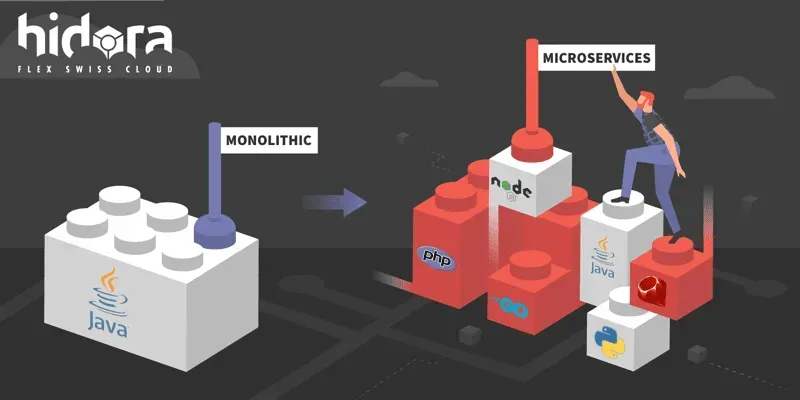To begin with, let’s understand the difference between microservices and a monolith.

Microservices
A microservice is an application composed of independent services that can run independently and scale freely on different servers. The microservice architecture is better organised than the monolithic architecture, since each microservice has a specific task.
The main advantage of microservices is that they are easy to reconfigure for different purposes. In addition, they are characterised by rapid deployment, fault tolerance, horizontal scaling, low barrier to entry and ease of management.
Imagine a smart home where all components can be controlled with the remote control: open the windows, turn on the TV or even close the curtains. This is how microservices architecture works.
Monolithic architecture
The second type of architecture is the monolithic architecture. Monolithic means that the components of a product are interconnected and interdependent, and linked as a single application. If one of the components stops working, the whole system fails.
Imagine a chocolate cake with several layers. Each new layer makes the cake tastier, but you can’t add a layer of strawberries in the middle without changing the taste and texture of the cake. We can assume that the cake has a monolithic architecture.
Disadvantages of monolithic architecture
- The components are too dependent on each other. If one of the modules fails for any reason, the whole application crashes as well. Imagine there is a web application in which there are modules, such as, authorization, payment, history, etc., and for some reason one of them fails. And for some reason, one of them crashes. And for some reason, one of them fails. It’s a real shock for companies and, therefore, for developers.
- The complexity of scaling. Scaling a monolithic application can only be done by scaling another similar application. But what if only one component needs to be scaled, not the whole application. How many resources will be wasted?
- Too much code. As the application develops, the amount of code written increases, which can overload the development environment every time you have to open it. This definitely reduces the efficiency of the developer. In addition, duplication of code in different modules of the application can be a problem, as they are often created by different developers.
- It is very difficult to switch to another programming language. Since you have to install everything in one place, switching to another programming language or technology is a big problem. For example, you wrote an application in Java, and after a while, GB came out and you had a burning desire to rewrite it, because it was cooler, better and faster. In the case of a monolithic application, just thinking about refactoring is a real pain, let alone the process itself. Right now, many applications are done this way and the number of lines of code is just incredible.
- Time-consuming development. This can have a significant impact on the development and release process. The larger the application, the more important it is for developers to be able to divide it into several functional parts. As all modules of a monolithic application are connected to each other, developers cannot work on these modules independently of each other. As developers are dependent on each other, their working time increases.
Almost all successful products reach a stage where adding new functionality to existing code becomes so difficult that the cost of the new functionality outweighs any possible benefits of using it. In this situation, you need to think about microservices.
Benefits of microservice architecture
The advantages of microservices seem to be enough to convince enterprise developers such as Amazon, Netflix, Ebay to start using this approach. Unlike applications with a monolithic architecture, microservices have the following advantages:
- Isolation of components. Large applications can continue to operate efficiently even if a single module fails. And if something goes wrong, it’s easier to roll back.
- Stack independence. The microservice architecture eliminates the commitment of the application to a single technology stack and allows a system to be built using different programming languages and technologies.
- Simplicity. New developers are more easily involved in the work - they don’t need to study the whole functionality of the service, you can just work on their part.
- Scalability. Scaling microservices is much easier, because to increase system performance you only need to develop the services that need it.
- Production release. You can release new versions of the application much faster, because developers from different teams do not have to wait for each other to create a new version of the application. They can therefore make versions in parallel and with a much lower volume of changes, which reduces the probability of errors.
If you want to use microservices, you need to understand that this approach requires additional knowledge in technologies such as Docker for component isolation, Kubernetes for management and Consul for service discovery. The journey may be long, but you don’t have to do it alone.
Hidora’s team can help you move from monolith to microservices, offering architectural consulting, mentoring and migration services by experienced professionals in all emerging technologies.








